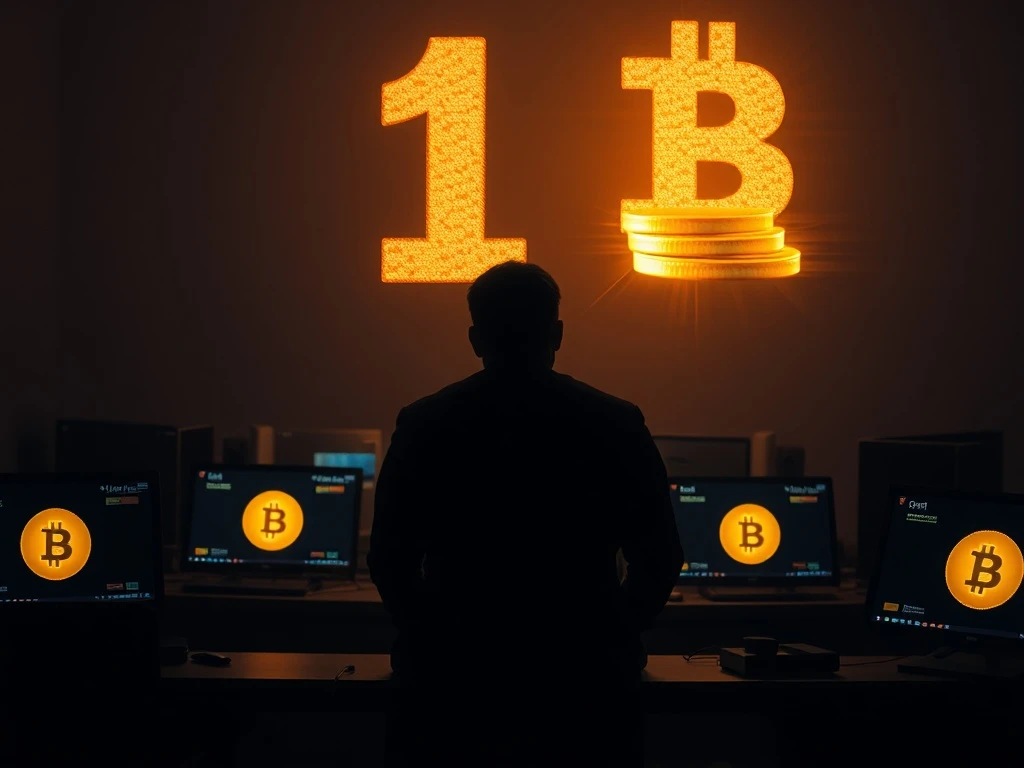Solo Bitcoin Miner Achieves Unbelievable $373,000 Reward Amidst Industry Shifts

In a world increasingly dominated by industrial-scale operations, the story of a lone Solo Bitcoin Miner securing a staggering $373,000 reward has sent ripples through the cryptocurrency community. This incredible feat not only defies the immense odds but also rekindles the spirit of decentralization that is foundational to Bitcoin. It’s a powerful reminder that even in a highly competitive landscape, individual effort can still yield monumental success.
The Unbelievable Feat of a Solo Bitcoin Miner
Imagine dedicating hours of computational effort, not knowing if your work will ever pay off, only for it to culminate in a life-changing sum. This is precisely what happened when an independent miner, utilizing the Solo CK pool, successfully solved a Bitcoin block. The reward? A hefty sum of $373,000, comprising the standard block incentive plus transaction fees. This rare achievement, first reported by Cointribune [1], stands as a testament to persistence and a stroke of luck in the highly probabilistic world of Bitcoin Mining.
For context, solving a Bitcoin block requires immense computational power to guess a specific hash. In today’s environment, this is usually achieved by large mining pools where thousands of miners combine their hash power and share rewards. A solo miner achieving this is akin to winning a lottery, yet it underscores a core principle of Bitcoin: its open and permissionless nature. Despite rising network difficulty and the concentration of hash power among large mining pools, this event proves that individual participation in Bitcoin’s consensus mechanism remains technically and economically viable, albeit statistically improbable [2].
Understanding Bitcoin Mining in a Centralized Era
The broader Bitcoin Mining landscape paints a picture of a sector under significant strain and evolution. Gone are the days when a simple home setup could consistently yield Bitcoin. Today, established players like Marathon Digital and Riot Platforms dominate the scene, deploying massive data centers filled with specialized hardware. These industrial-scale operations benefit from economies of scale, including access to low-cost energy and optimized cooling systems, advantages largely inaccessible to individual miners.
Recent trends show these large firms facing profitability challenges. Texas-based miners, for instance, have often curtailed energy use to avoid peak-hour costs, temporarily reducing block production. Many are also pivoting towards diversified strategies, redirecting their infrastructure to high-performance computing or AI data centers. Bitcoin mining, once a standalone revenue stream, is increasingly seen as a complementary activity rather than a core business for these giants. Yet, exceptions like this solo miner’s success highlight the network’s inherent resilience and the potential for unexpected outcomes.
The Economic Impact of a Crypto Mining Reward
The $373,000 Crypto Mining Reward is a substantial windfall for any individual, far exceeding the operational costs for most solo miners. This illustrates the potential for outsized gains under favorable conditions, though it’s crucial to remember that such outcomes are outliers. While large-scale operations prioritize consistent, albeit smaller, returns through pooling, a solo win offers a glimpse into the immense value locked within Bitcoin’s block rewards.
The economic implications of this event are twofold:
- Validation of Open Access: It reinforces the system’s design as inherently open to all participants, regardless of scale, upholding Bitcoin’s foundational principles of open access and proof-of-work.
- Potential for Outsized Gains: The reward significantly outweighs the typical investment and operational costs for a solo miner, demonstrating the lottery-like potential for life-changing earnings.
Analysts note that while pooling remains the norm for consistent returns, rare solo wins like this one validate Bitcoin’s foundational principles. The miner’s success may also be partly attributable to lower network difficulty or temporary market conditions, aligning with historical patterns where smaller players occasionally outpace giants during network adjustments [1].
Challenges and Opportunities in a Decentralized Blockchain
This solo miner’s success story reignites critical debates about the future of Bitcoin and the very nature of a Decentralized Blockchain. Critics often argue that environmental concerns and increasing regulatory scrutiny threaten the industry’s viability. The energy consumption of Bitcoin mining remains a hot topic, with ongoing efforts to shift towards more sustainable energy sources.
However, proponents highlight this miner’s win as a powerful testament to the network’s enduring appeal and its resistance to full centralization. It demonstrates that the network’s design, while favoring scale, still allows for individual participation and unexpected victories. This event also raises questions about the long-term sustainability of solo mining as energy costs rise and hardware complexity increases. Yet, it serves as a powerful reminder that Bitcoin’s algorithmic design retains an element of unpredictability, allowing for occasional underdog victories that reinforce its core ethos.
Navigating Mining Profitability and Market Dynamics
The economic value of this impressive reward, denominated in Bitcoin, is inherently subject to market volatility. While the miner’s windfall is fixed at the time of block confirmation, its USD value will fluctuate based on Bitcoin’s price at conversion. CoinGecko’s data indicates Bitcoin’s price has recently traded within a narrow range [3], though significant price movements post-minting could amplify or dilute earnings.
This volatility adds a layer of risk to Mining Profitability. Gains from mining are inherently tied to broader market sentiment and the unpredictable nature of cryptocurrency prices. For solo miners, timing the conversion of their Bitcoin reward into fiat currency becomes a crucial decision. Despite the risks, the sheer magnitude of this solo win highlights the potential for significant gains, making it a compelling narrative for anyone interested in the raw, unpredictable power of the crypto market.
A Beacon of Hope for the Individual Miner
The incredible achievement of this solo Bitcoin miner is more than just a headline; it’s a powerful narrative that resonates deeply within the cryptocurrency community. It serves as a beacon of hope, reminding us that even in an increasingly industrialized and complex landscape, the fundamental principles of decentralization and open access still hold true. While large-scale operations navigate market pressures and strategic shifts, this single act of defiance against overwhelming odds showcases Bitcoin’s resilience and its capacity for rewarding individual endeavor. It’s a story that will undoubtedly inspire many and continue to fuel debates about the future of mining and the enduring spirit of Bitcoin.
Frequently Asked Questions (FAQs)
1. How rare is it for a solo Bitcoin miner to solve a block?
It is extremely rare. With the current network difficulty and the dominance of large mining pools, the probability of a solo miner solving a block is statistically very low, often compared to winning a lottery. Most solo miners join pools for more consistent, albeit smaller, payouts.
2. What is the ‘Solo CK pool’ mentioned in the article?
Solo CK is a specific mining pool designed for solo miners. Unlike traditional pools where rewards are shared, Solo CK allows miners to direct their hash power towards attempting to solve blocks individually. If successful, the entire block reward goes to the solo miner, minus a small pool fee.
3. Why are large mining operations struggling despite their scale?
Large mining operations face challenges due to rising energy costs, fluctuating Bitcoin prices, and increasing network difficulty. They often have significant operational overheads, and market downturns or energy price spikes can severely impact their profitability. This has led many to diversify into other areas like HPC or AI data centers.
4. Does this event mean solo Bitcoin mining is now a viable strategy for everyone?
While inspiring, this event does not make solo Bitcoin mining a generally viable strategy for most individuals. The statistical improbability remains high. For consistent returns, joining a mining pool is still the recommended approach for most participants. This particular success was an outlier.
5. How does Bitcoin’s price volatility affect mining rewards?
Mining rewards are paid in Bitcoin. While the number of Bitcoins received for solving a block is fixed, its USD value fluctuates directly with Bitcoin’s market price. A miner’s financial gain can increase or decrease significantly between the time of earning the reward and converting it to fiat currency.










